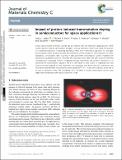| dc.contributor.author | Logan, Julie V. | |
| dc.contributor.author | Short, Michael P | |
| dc.contributor.author | Webster, Preston T. | |
| dc.contributor.author | Morath, Christian P. | |
| dc.contributor.author | Steenbergen, Elizabeth H. | |
| dc.date.accessioned | 2020-03-30T19:28:47Z | |
| dc.date.available | 2020-03-30T19:28:47Z | |
| dc.date.issued | 2019-08 | |
| dc.date.submitted | 2019-06 | |
| dc.identifier.issn | 2050-7534 | |
| dc.identifier.issn | 2050-7526 | |
| dc.identifier.uri | https://hdl.handle.net/1721.1/124428 | |
| dc.description.abstract | Critical satellite-based electronics can fail due to irradiation with Van Allen belt trapped protons. While nuclear-reaction-induced transmutation damage is typically ignored, a recent study raised the question of its potential importance in explaining anomalous trends in III-V nBn device operation. To investigate this postulation and to generally quantify the importance of transmutation in semiconductors for space applications, transmutation rates occurring in eight prominent semiconductor systems irradiated with typical device qualification protons of 63 MeV and operating in LEO, MEO, and GEO orbits are examined computationally employing FISPACT-II (validated through experiment and GEANT4 simulations). It is found that the transmutation realized in the III-V nBn device is three orders of magnitude less than would have been required to bring experiment into agreement with theory and that, furthermore, the total transmuted elemental concentrations never exceed 1010 cm-³ in any semiconductor at the end of 10 years of operation in any orbit considered. Thus, the effect of nuclear transmutation can be safely neglected in predicting modern device operation in orbit. ©2019 The Royal Society of Chemistry. | en_US |
| dc.language.iso | en | |
| dc.publisher | Royal Society of Chemistry (RSC) | en_US |
| dc.relation.isversionof | 10.1039/c9tc02995h | en_US |
| dc.rights | Creative Commons Attribution 3.0 unported license | en_US |
| dc.rights.uri | https://creativecommons.org/licenses/by/3.0/ | en_US |
| dc.source | Royal Society of Chemistry (RSC) | en_US |
| dc.title | Impact of proton-induced transmutation doping in semiconductors for space applications | en_US |
| dc.type | Article | en_US |
| dc.identifier.citation | Logan, Julie V., et al., "Impact of proton-induced transmutation doping in semiconductors for space applications." Journal of Materials Chemistry C 29 (2019): p. 8739-9114 doi 10.1039/c9tc02995h ©2019 Author(s) | en_US |
| dc.contributor.department | Massachusetts Institute of Technology. Department of Nuclear Science and Engineering | en_US |
| dc.relation.journal | Journal of Materials Chemistry C | en_US |
| dc.eprint.version | Final published version | en_US |
| dc.type.uri | http://purl.org/eprint/type/JournalArticle | en_US |
| eprint.status | http://purl.org/eprint/status/PeerReviewed | en_US |
| dc.date.updated | 2020-02-27T18:35:23Z | |
| dspace.date.submission | 2020-02-27T18:35:25Z | |
| mit.journal.volume | 29 | en_US |
| mit.license | PUBLISHER_CC | |
| mit.metadata.status | Complete | |
